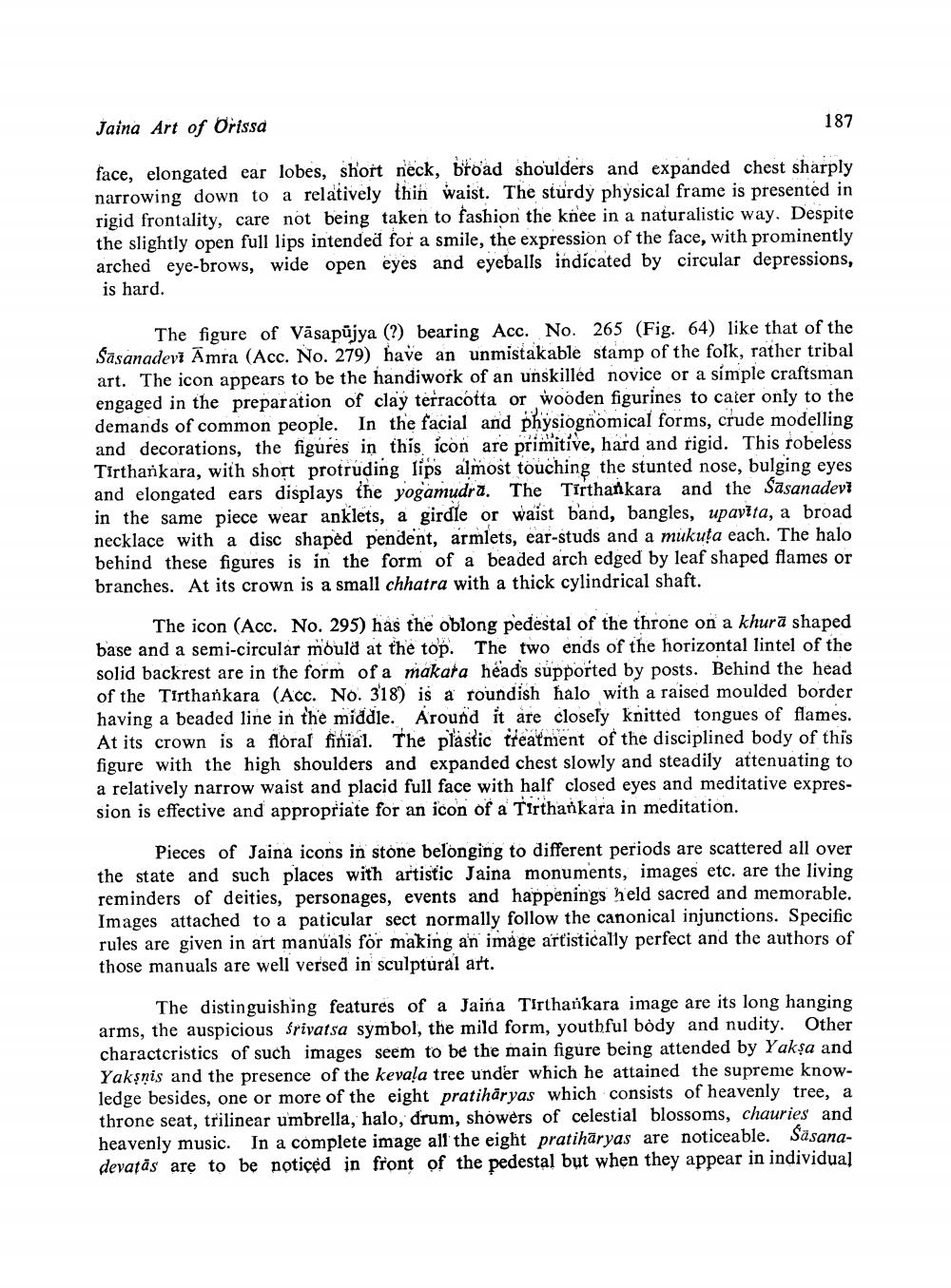________________
Jaina Art of Orissa
187
face, elongated ear lobes, short neck, broad shoulders and expanded chest sharply narrowing down to a relatively thin waist. The sturdy physical frame is presented in rigid frontality, care not being taken to fashion the knee in a naturalistic way. Despite the slightly open full lips intended for a smile, the expression of the face, with prominently arched eye-brows, wide open eyes and eyeballs indicated by circular depressions, is hard.
The figure of Vāsapūjya (?) bearing Acc. No. 265 (Fig. 64) like that of the Sasanadevi Amra (Acc. No. 279) have an unmistakable stamp of the folk, rather tribal art. The icon appears to be the handiwork of an unskilled novice or a simple craftsman engaged in the preparation of clay terracotta or wooden figurines to cater only to the demands of common people. In the facial and physiognomical forms, crude modelling and decorations, the figures in this icon are primitive, hard and rigid. This robeless Tirthařkara, with short protruding lips almost touching the stunted nose, bulging eyes and elongated ears displays the yogamudra. The Tirthankara and the Sasanadevi in the same piece wear anklets, a girdle or waist band, bangles, upavita, a broad necklace with a disc shaped pendent, armlets, ear-studs and a mukuta each. The halo behind these figures is in the form of a beaded arch edged by leaf shaped flames or branches. At its crown is a small chhatra with a thick cylindrical shaft.
The icon (Acc. No. 295) has the oblong pedestal of the throne on a khurā shaped base and a semi-circular mould at the top. The two ends of the horizontal lintel of the solid backrest are in the form of a makata heads supported by posts. Behind the head of the Tirthankara (Acc. No. 318) is a roundish halo with a raised moulded border having a beaded line in the middle. Around it are closely knitted tongues of flames. At its crown is a floral finial. The plastic treatment of the disciplined body of this figure with the high shoulders and expanded chest slowly and steadily attenuating to a relatively narrow waist and placid full face with half closed eyes and meditative expression is effective and appropriate for an icon of a Tirthankara in meditation.
Pieces of Jaina icons in stone belonging to different periods are scattered all over the state and such places with artistic Jaina monuments, images etc. are the living reminders of deities, personages, events and happenings held sacred and memorable. Images attached to a paticular sect normally follow the canonical injunctions. Specific rules are given in art manuals for making an image artistically perfect and the authors of those manuals are well versed in sculptural art.
The distinguishing features of a Jaina Tirthankara image are its long hanging arms, the auspicious frivatsa symbol, the mild form, youthful body and nudity. Other characteristics of such images seem to be the main figure being attended by Yakșa and Yakşnis and the presence of the kevala tree under which he attained the supreme knowledge besides, one or more of the eight pratihāryas which consists of heavenly tree, a throne seat, trilinear umbrella, halo, drum, showers of celestial blossoms, chauries and heavenly music. In a complete image all the eight pratihāryas are noticeable. Sasanadevatās are to be noticed in front of the pedestal but when they appear in individual




